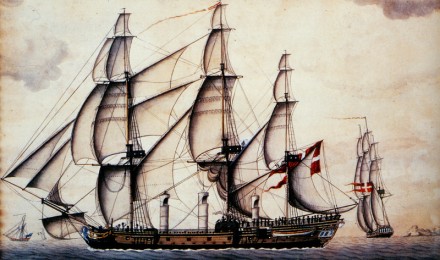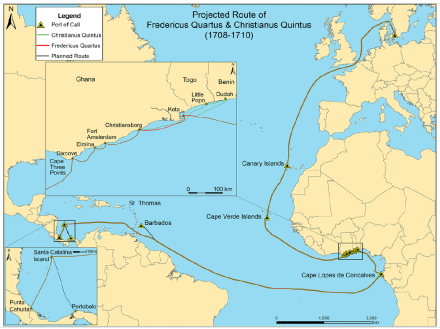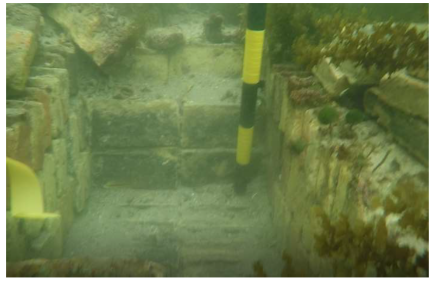History
In the bay of Cahuita (Costa Rica) lie two shipwrecks that have been known for a long time. In the traditions there has always been talk about two pirate ships. After archaeological research (Harris, Richards 2018.) it was suspected that they were not pirate ships but two Danish slave ships; The 'Christian V' and the 'Frederik IV' that disappeared in 1710.
In 2023, the wrecks were therefore investigated again by Danish maritime archaeologists. Analysis of wood samples, clay pipes and specific yellow bricks has yielded a Danish origin and a dating around 1700. This has almost definitively established that these are the two Danish slave ships.

The 'Frederik IV' was a frigate 144 feet long built in Copenhagen (originally called The Copenhagen Stock Exchange)
She left Copenhagen in December 1708 together with Christian V for a voyage to West Africa to buy slaves and then sell them on the Danish Caribbean island of St. Thome.
Slave coast
The first leg led to the Danish fort Christiansborg on the Gold Coast (Ghana). The ships arrived there in March 1709. There, gold, ivory and slaves had to be loaded. Gold and ivory were in stock but enslaved prisoners were scarce. In such cases, it became a search along various slave entrepots along the West African coast to obtain the human merchandise.

The first leg led to the Danish fort Christiansborg (Cape Three Points) on the Gold Coast (Ghana). The ships arrived there in March 1709. There, gold, ivory and slaves had to be loaded. Gold and ivory were in stock but enslaved prisoners were scarce. In such cases, it became a search along various slave entrepots along the West African coast to obtain the human merchandise.
West Indies
Sources have been found in the Danish archives which seem to indicate that the two captains conspired to deliver the slaves not to St Thomas but to the Spanish Porto Bello from the beginning. Higher prices could be asked there.
Be that as it may. The ships came to anchor 300 miles past St Thomas at an old pirate nest, the islet of Santa Catalina. They decided there that they could not return because of the total lack of food. The skippers decided to sail on to Portobello to refresh there and sell the slaves. At that time there were still 671 prisoners alive.
End
It didn't get that far. On the way they had to anchor again in a bay (Punta Cahuita) in the south of Costa Rica. The crew absolutely did not want to continue there. They forced the officers to release the prisoners to save food and the money chests were plundered. The Frederik IV was set on fire. The Christian V did not fare much better. The anchor rope was cut, causing the ship to run aground and sink in the surf.
Part of the crew returned to Denmark via Porto Bello. The enslaved people escaped largely in the forests and merged with the local population.
Description
Built: Copenhagen
Owner: The ship was half owned by the firm Treschow & Dreyer (Vestindisk-guineisk Kompagnis) and the other half by the private shipowner/merchant Jacob Lerche.
| Master | Diderik Pfeiffer. |
|---|---|
| Length | 144 Amsterdam feet (40.8 m) |
Status
Research
The earliest archaeological exploration dates back to 1981 (Gluckman)
30 years later, a team from East Carolina University (US) conducted research between 2015 and 2019. The site was mapped and finds described (Harris, Richards 2018)

In 2023, the two wrecks were again investigated by archaeologists from the National Danish Museum and the Viking Ship Museum. Analysis of wood samples, clay pipes and specific yellow bricks has revealed a Danish origin and a dating around 1700.
"The analyses are very convincing and we no longer doubt that these are the wrecks of the two Danish slave ships," said David Gregory, maritime archaeologist and head of the maritime research center Njord at the National Museum of Denmark. He emphasized the charred and sooty wood, which fits perfectly with historical accounts of a burning ship.
References
- Harris,L, Richards, N. (2018).
Preliminary Investigations of Two Shipwreck Sites in Cahuita National Park, Costa Rica.
International Journal of Nautical Archaeology. - Gluckman, S. (1992).
Preliminary investigation of a shipwreck, Pumpata Cahuita National Park, Costa Rica, in L. Babits and H. Van Tilberg (eds),
Maritime Archaeology: A Reader of Substantive and Theoretical Contributions, 453–469. - arkeonews.
centuries-old-shipwrecks-in-costa-rica-identified-as-danish-slave-ships.